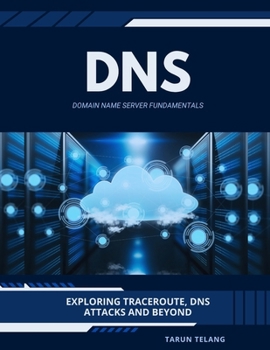Domain Name Server (DNS) Fundamentals: Exploring Traceroute, DNS Attacks and Beyond
DNS translates human-readable domain names into machine-readable IP addresses. Despite its importance, DNS is one of the most misunderstood components of network infrastructure.
When DNS is not working properly, you can't get access to websites. When it is not configured correctly, it can lead to slow loading times and connectivity issues. If compromised by hackers, it opens the door to serious security breaches and cyberattacks.
"DNS Fundamentals: Exploring Traceroute, DNS Attacks, and Beyond" is your go-to guide for understanding this essential internet protocol.
What You'll LearnThis book takes a practical approach by combining fundamental concepts with real-world diagnostic tools and security considerations for DNS. Here's what it will cover:
DNS FundamentalsDNS Record Types: Master A, AAAA, CNAME, MX, TXT, NS, PTR, SOA, SRV, and CAA recordsEssential Tools: Learn to use nslookup, dig, and whois commands for DNS troubleshootingPractical Applications: Understand how DNS records impact SEO, email campaigns, and website performanceZone Files & Configuration: Configure DNS records using industry-standard formats (RFC 1034/1035)Network DiagnosticsTraceroute Fundamentals: Understand how packets traverse networks using TTL valuesDiagnostic Techniques: Identify network bottlenecks, routing issues, and performance problemsReading Traceroute Output: Interpret hop counts and response times, and identify problem areasCross-Platform Tools: Master both Unix traceroute and Windows tracert commandsTroubleshooting Strategies: Systematic approaches to network problem resolutionDNS Architecture & ManagementDNS Redirects: Implement CNAME, URL, permanent (301), and temporary (302) redirectsExternal DNS: Leverage public DNS providers for performance and reliabilityDNS Suffixes: Configure search domains and resolution behaviorPrivate DNS: Design internal DNS infrastructure for organizational networksTTL Management: Optimize caching strategies for performance and flexibilitySecurity & Attack PreventionCommon Attack Vectors: DNS hijacking, cache poisoning, and spoofing techniquesThreat Identification: Recognize signs of DNS-based attacks and compromisesMitigation Strategies: Implement defensive measures and security best practicesIncident Response: Handle DNS security breaches and recovery proceduresAdvanced TopicsDNS TTL Optimization: Balance performance, reliability, and change flexibilityTCP/IP Integration: Understand DNS within the broader network protocol stackDomain Registration: Navigate the domain acquisition and management processPerformance Tuning: Optimize DNS resolution for speed and reliabilityWhat Each Chapter ProvidesEach chapter includes:
Step-by-step command examples with actual outputReal-world troubleshooting scenariosBest practices from industry experienceCommon pitfalls and how to avoid themAdditional resources for further learning and developmentTarget AudienceThis book is designed for:
Primary AudienceNetwork administrators, IT professionals, system engineers
Secondary AudienceStudents, technology enthusiasts, CompTIA certification candidates
Experience LevelBeginner to intermediate (accessible to all levels)
New York Best Seller recognition as one of the best DNS books according to BookAuthority.org




